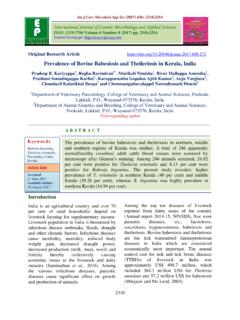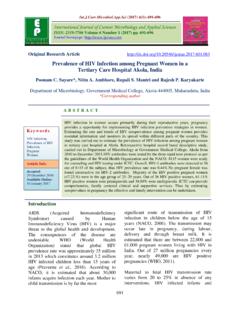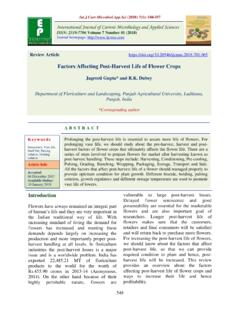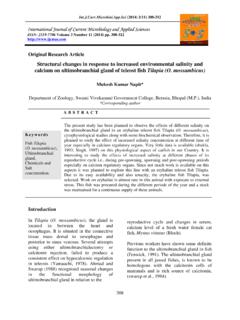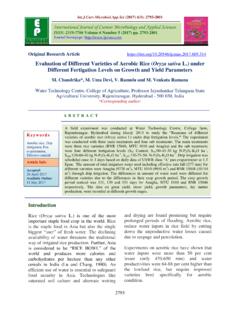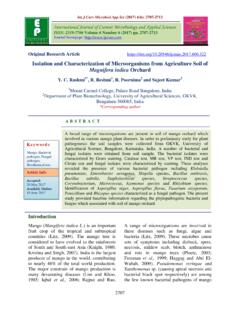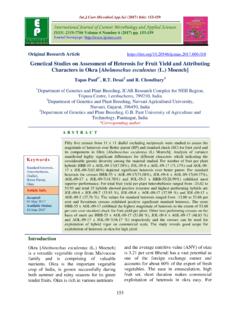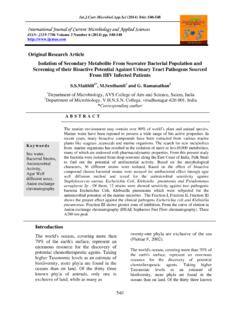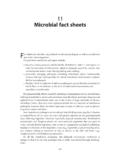Transcription of Phosphate Solubilizing Microbes: An Overview - IJCMAS
1 (2017) 6(1): 844-852 844 Review Article Phosphate Solubilizing microbes : An Overview Krishnananda Pralhad Ingle1* and Dipika Ashokrao Padole2 Biotechnology Centre, Dr. Panjabrao Deshmukh Krishi Vidyapeeth, Akola, Maharashtra, India *Corresponding author A B S T R A C T Introduction To meet the demand of overgrowing population it is the need of agrarian community to enhance the yield and future food supply. To overcome these problems, efforts needed to focus the soil biological system and the agro-ecosystem for better understanding the complex processes and their interactions for governing the stability of agricultural land. The green revolution has been proved the most intellectual human activities contributing global food security and, consequently, changes the face of developing countries, such as India, from being food-deficient to having a food surplus.
2 In present conditions there is an urgent need of second green revolution to increase the food production by around 50% in coming next 20 International Journal of Current Microbiology and Applied Sciences ISSN: 2319-7706 Volume 6 Number 1 (2017) pp. 844-852 Journal homepage: K e y w o r d s Phosphate solubalizing microorganisms (PSM), Plant growth promoters (PGPR), Mechanism of P solubilization, Accepted: 28 December 2016 Available Online: 10 January 2017 Article Info Phosphorous is one of the most abundant metallic element found in the earth s crust and present in soils in both organic and inorganic forms. Though it is present in high concentration, only of the total P is available to plant because of poor solubility and its fixation in soil with other metallic elements in the soil such as Ca, Al, Fe to form calcium Phosphate , aluminum Phosphate and ferrous Phosphate and thus becomes unavailable to plants.
3 Tremendous application of chemical based P fertilizers has long term impact on the environment in terms of eutrophication, soil fertility depletion, carbon footprint this attitude compelled us to find a sustainable approach for efficient P availability in agriculture to meet the over growing demand of food. The use of efficient PSM ( Phosphate - Solubilizing microorganisms), opens up a new horizon for better crop productivity and for greater yield performance without affecting the soil health. Phosphate Solubilizing microorganism plays an important role in the plant nutrition through increase in P uptake by the plants and their use as PGPR is an important contribution to biofertilization of agricultural crops. Though some of the bacterial strain such as (Pseudomonads and bacilli) and fungal strains (Aspergillus and Penicillium) have been identified as PSM their relative performance under in situ conditions is not reliable and therefore there is a need of genetically modified strains which could lead better P solubilizition and improve the plant health.
4 The present review mostly focuses on the Phosphate plant interaction, PSM, mechanism of P solubilization, PSM as plant growth promoter and genetic manipulation of several genes involved in mineral and Phosphate P solubilization. (2017) 6(1): 844-852 845 years to fulfill the demand of increasing population pressure (Vasil, 1998; Leisinger, 1999). Chemical fertilizers, such as water-soluble phosphatic (WSP) fertilizers have played a significant role in the green revolution to rectify the phosphorus deficiencies. However, excessive use of chemical pesticides arises soil health issues and beyond certain limit the yield plateau get declined (Ahmed, 1995). Thus it becomes clear that conventional agricultural practices cannot sustain the production base, for too long; while, to augment crop productivity agronomists have to rely on chemical fertilizers.
5 In this context, after nitrogen, phosphorus is an essential plant nutrient whose deficiency marked the high yield. The phosphorous is present only in micro molar or lesser quantities in the earth s crust (Ozanne, 1980) and is highly reactive with other elements in the soil. Phosphorous is a one of the most abundant metallic elements found in the earth s crust and is present in the soils in both inorganic and organic forms (Gyaneshwar et al., 2002). It is utilized or absorbed by the plants in inorganic form in orthophosphate (H2PO4-and HPO42-) (Hinsinger, 2001). It has a key role in metabolic processes such as photosynthesis, energy transfer, signal transduction, nitrogen fixation in legumes, crop quality and resistance to plant diseases are the main features associated with phosphorous nutrition (Sperber, 1958a; Khan et al, 2014).
6 Phosphorus being a structural component of many coenzymes, phospho-proteins, phospholipids (Ozane et al., 1980) also forms a part of the genetic memory DNA of all living organisms. It involved in transfer and storage of energy which used for growth and reproduction. Phosphorus plays a lead role in especially in photosynthesis, carbon metabolism, and membrane formation (Wu, 2005) also the vital role in elongation of root, proliferation, and phosphorous deficiency affects root architecture (Borch et al., 1999; Williamson et al., 2001). A major portion of phosphorus absorbed by the plant is accumulated in grain in the form of phytic acid which becomes unavailable to plants and its deficiency negatively affects grains yield (Richardson, 1994). Tropical and subtropical regime has acidic soil considered as extremely deficient in phosphorus with high phosphorus sorption (fixation) capacities.
7 On average, most mineral nutrients in soil solution are present in millimolar amounts but phosphorus is present only in micromolar or lesser quantities (Ozanne, 1980). The low levels of phosphorus are due to high reactivity of soluble Phosphate with other elements. A number of heterotrophic microorganisms excreting organic acids which solubalized P that chelate cationic partners of P ions and release the P directly into solution (He et al., 2002). These Phosphate Solubilizing bacteria (PSB) are being used as biofertilizer since 1950s. Microbial inoculants assimilate soluble P, and prevents it from adsorption or fixation (Khan and Joergesen, 2009). These microorganisms influences soil fertility through various processes viz.
8 Decomposition, mineralization and release of nutrients. Microorganisms enhance the P availability to plants through solubilization of inorganic form of P to in available form (Chen et al., 2006; Kang et al., 2002). Hence, microbial inoculants are used as an alternate source, which are both economic as well as eco-friendly. A continued exploration of the natural biodiversity of soil microorganisms and the optimization of microbial interactions in the rhizosphere represents a prerequisite step to develop the more efficient microbial inoculants with phosphorus- Solubilizing ability. (2017) 6(1): 844-852 846 Phosphate Plant Interaction Phosphorus is one the major nutrient limiting plant growth. It has diverse role in plant nutrition and promotes the development of deeper roots.
9 The soil that is rich in phosphorus constitutes about (w/w) phosphorus but only one tenth of this is available to plants. Most of the P (95-99%) present in the soil in the insoluble form and hence cannot be utilized by the plants due to chemical fixation in the soil and it s interaction with other metallic elements that are present in the rhizospheric area (Gaur and Gaind, 1999). To increase the availability of phosphorus for plants, large amounts of fertilizer is used on a regular basis. But the continuous application of fertilizer P is rapidly transferred to the insoluble forms (Abd Alla, 1994) and thus there is a need of Phosphate Solubilizing microorganism to make the P in available form to the plants.
10 Phosphate Solubilizing Micro-Organisms Naturally occurring rhizospheric phosphorus Solubilizing microorganism (PSM) dates back to 1903 (Khan et al., 2009). Number of microbial species plays key role in P solubilization these includes bacteria, fungi, actinomycetes and even algae. Bacteria are predominant amongst them and proved more effective in phosphorus solubilization than fungi. In addition to Pseudomonas and Bacillus, other bacteria reported as P-solubilizers these are Rhodococcus, Arthrobacter, Serratia, Chryseobacterium, Phyllobacterium etc. (Wani et al. 2005), Azotobacter (Kumar et al. 2001), Xanthomonas (De Freitas et al. 1997), Enterobacter, Pantoea, and Klebsiella (Chung et al. 2005). Several halophilic bacteria Kushneria sinocarni have also been isolated from the sediment of Daqiao saltern on the eastern coast of China, which may be useful in stress conditions; salt affected agricultural soils (Zhu et al.)

